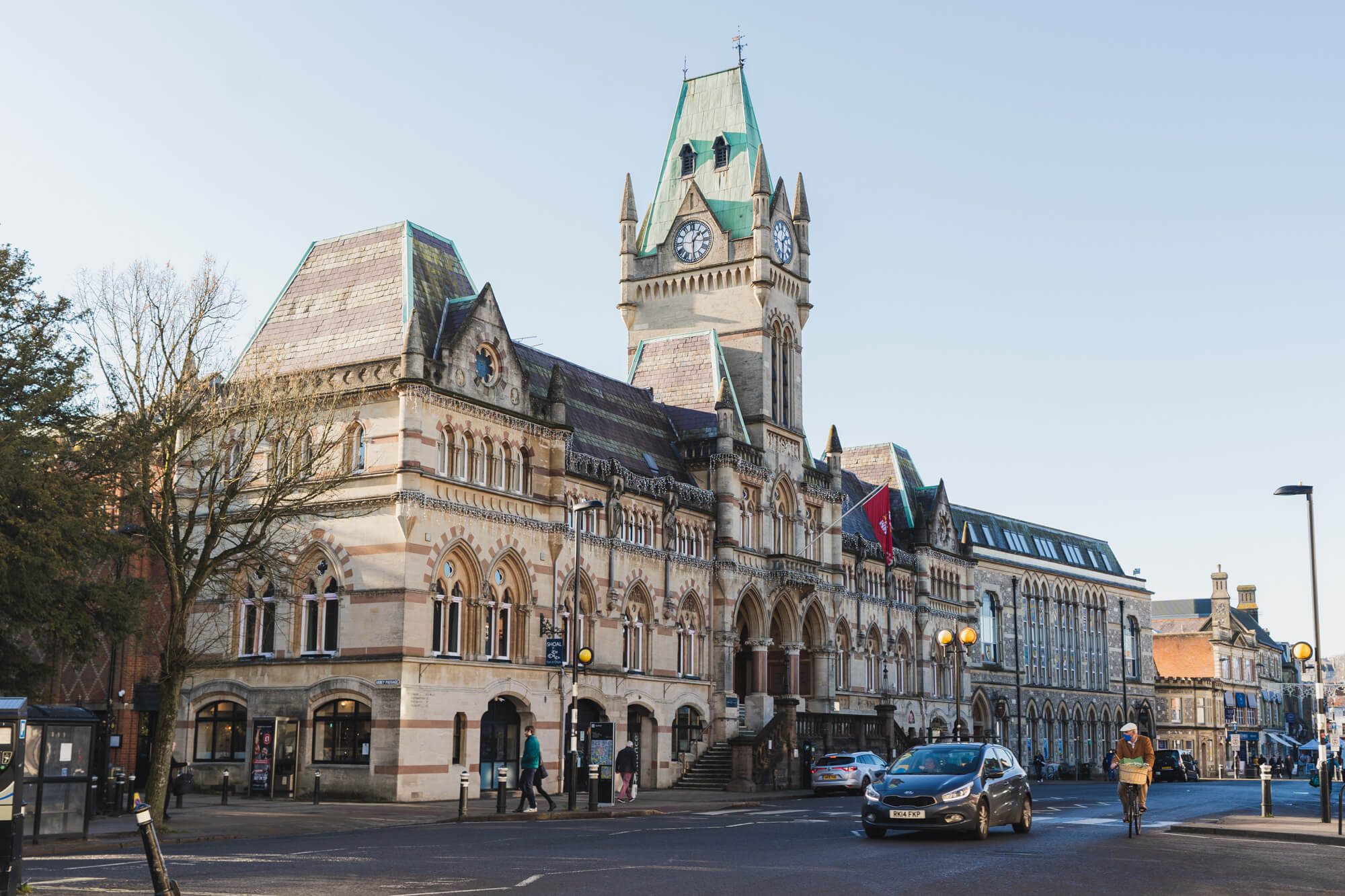*FYI - this post may contain affiliate links, which means we earn a commission at no extra cost to you if you purchase from them. Also, as an Amazon Associate I earn from qualifying purchases. Check out our Privacy Policy and Disclosure for more info.
From medieval round tables to world-famous cathedrals, those in search of places to visit in Winchester have plenty of fascinating choices.
As the first-ever capital of England, you would expect that Winchester has a few historic attractions, and you’d definitely be correct!
Winchester is most famous for its cathedral but there are actually many more interesting spots to explore, including multiple majestic structures that will have you drooling your way through town.
In this post, we’ll be sharing our top picks for places to visit in Winchester, including the best museums and historic buildings you can’t miss.
We hope you enjoy learning about this ancient city and be sure to let us know in the comments which Winchester must-sees we should add to our list!
Winchester Cathedral
Winchester Cathedral is far and away the most famous of Winchester’s tourist attractions, enticing more than 365,000 visitors each year to come and marvel at its Gothic architecture.
First built between 1079 and 1532, Winchester Cathedral is the longest medieval cathedral in the world. It’s also the sixth-largest cathedral in the United Kingdom and is dedicated to a number of saints. In fact, the official name of the cathedral is the Cathedral Church of the Holy Trinity, Saint Peter, Saint Paul and Saint Swithun… so you can see why we don’t usually call it that.
The interior of Winchester Cathedral is simply stunning, and well worth the £10 admission fee for its beauty alone, but there’s plenty of historic appeal to admire as well.
For instance, it was here in 1554 that Queen Mary Tudor married Prince Philip II of Spain. It was also here that in 1817 that the British novelist Jane Austen was buried upon her death, and, more recently, it was here that film crews for both the Da Vinci Code and The Crown created scenes taking place at Saint Paul’s Cathedral and Westminster Abbey.
Fun Fact: The Pilgrim’s Way route to Canterbury Cathedral actually begins right here at Winchester Cathedral, if you don’t mind the 153 mile trek.
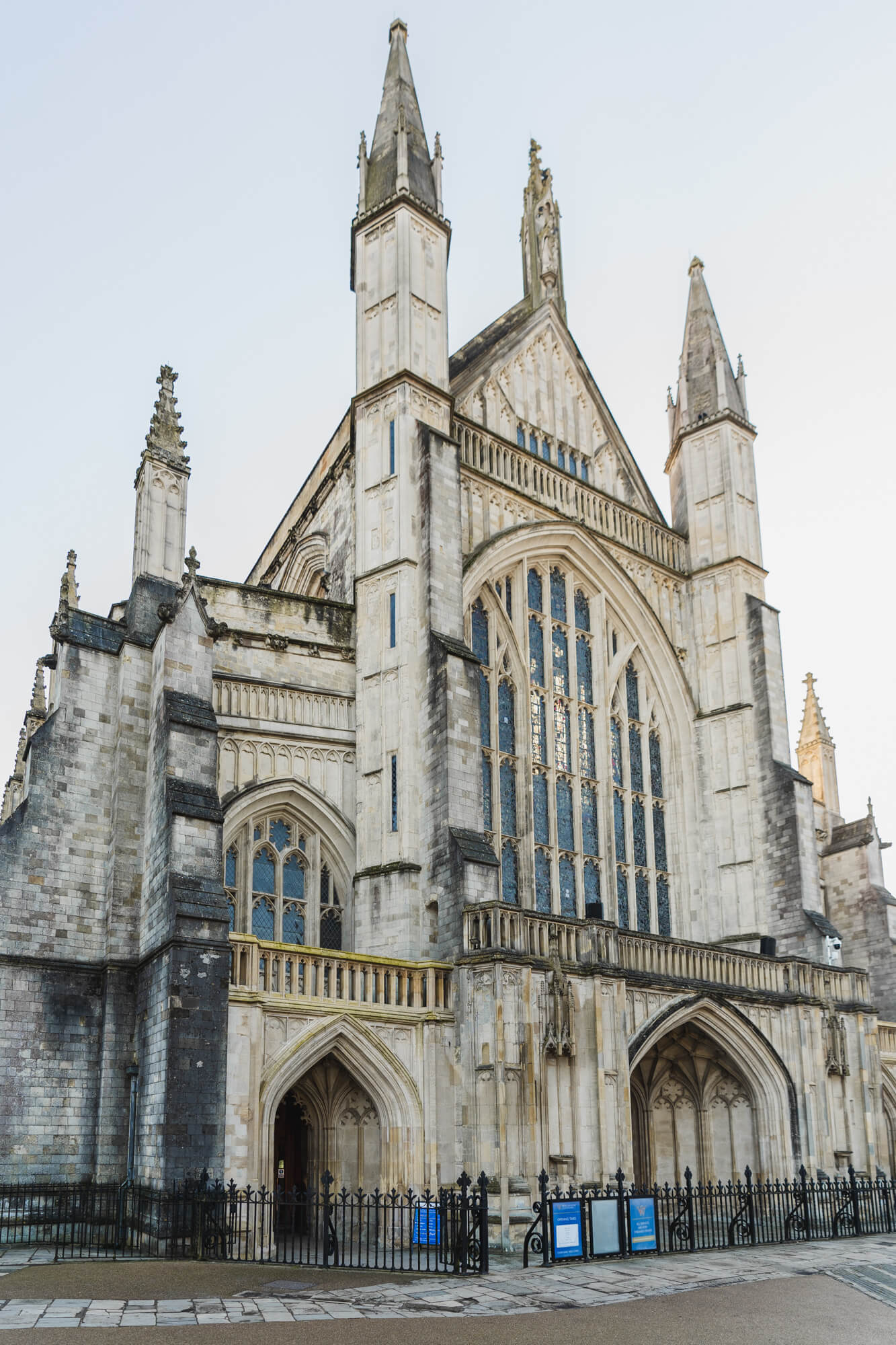
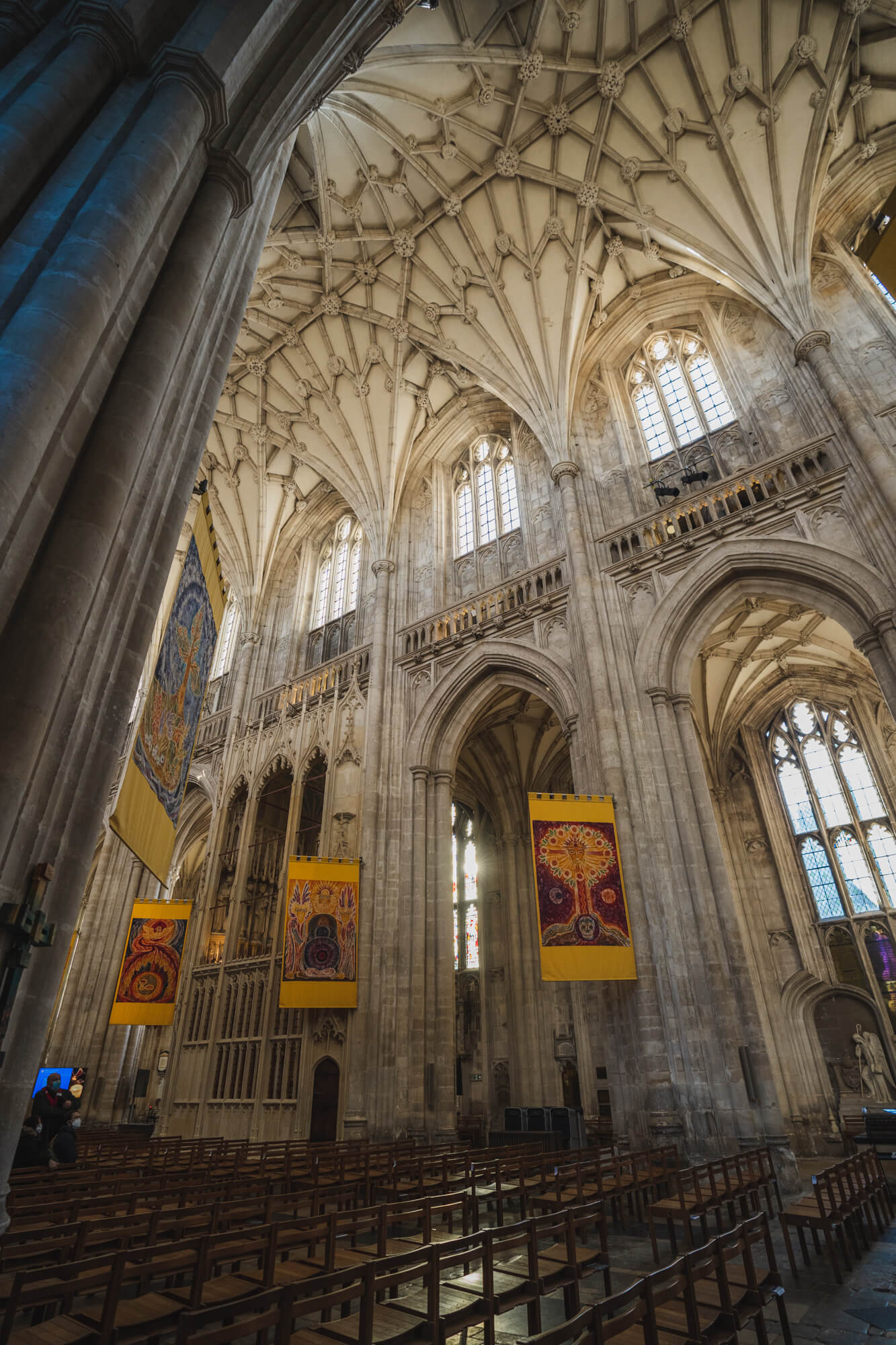
King Arthur’s Round Table at the Great Hall
Ever wanted to see King Arthur’s Round Table? Well, in Winchester you can….. sort of.
Winchester Castle was one of the first Norman castles built in England by William the Conqueror in 1067 and served as a seat of government for Norman Kings for over 100 years.
Today, the only part of the castle that remains is the Great Hall. Added by Henry III, the Great Hall was built between 1222 and 1235, with its starring attraction dating back to this period as well… meaning sadly, this isn’t the actual Round Table of Arthurian lore, but it’s still a fairly impressive (and nonetheless historic) replica, and well worth the small entry fee to visit.
Spanning 18ft in diameter, and weighing over 1200kg, this table dates back to the 13th century, but it wasn’t until the reign of King Henry VIII that it was jazzed up with its now distinctive painting of King Arthur (which bears an uncanny resemblance to Henry VIII himself, because of course it does), surrounded by the names of King Arthur’s Knights.
Locals spent centuries believing this table was indeed the real deal, but sadly radiocarbon dating refuted that claim back in the 1970s. It is now believed that the table was likely constructed for a Round Table Tournament in the Medieval Times, and hangs proudly in the Great Hall for all to admire.
PRACTICAL INFORMATION FOR VISITING: It costs £4 to visit The Great Hall as well as the 13th-century Queen Eleanor’s Garden and the Long Gallery. The Great Hall is usually open every day between 10am-5pm but check the website as it is occasionally closed for private or civic functions.

The Winchester Guildhall
Winchester’s Guildhall is another stunning building, built in 1871 in the Gothic Revival style. However, the history of the site is just as interesting as the building which stands there today.
King Alfred the Great’s widow, Aelswith, founded a nunnery on the site and retired there after his death in 899 AD. This nunnery became St Mary’s Abbey and was one of the largest nunneries in the country before the dissolution of the monasteries by Henry VIII.
St Mary’s Abbey was demolished but the land remained under control of the crown until it was gifted to the city by Mary Tudor for their help staging her marriage to Phillip II of Spain. Today’s Guildhall was constructed on the spot in the 1870’s, although it has been extended and renovated multiple times in the years since.
The Winchester Visitor Information Centre is located inside the Guildhall, and the building is often hired for private functions, as well as regularly hosting public events.
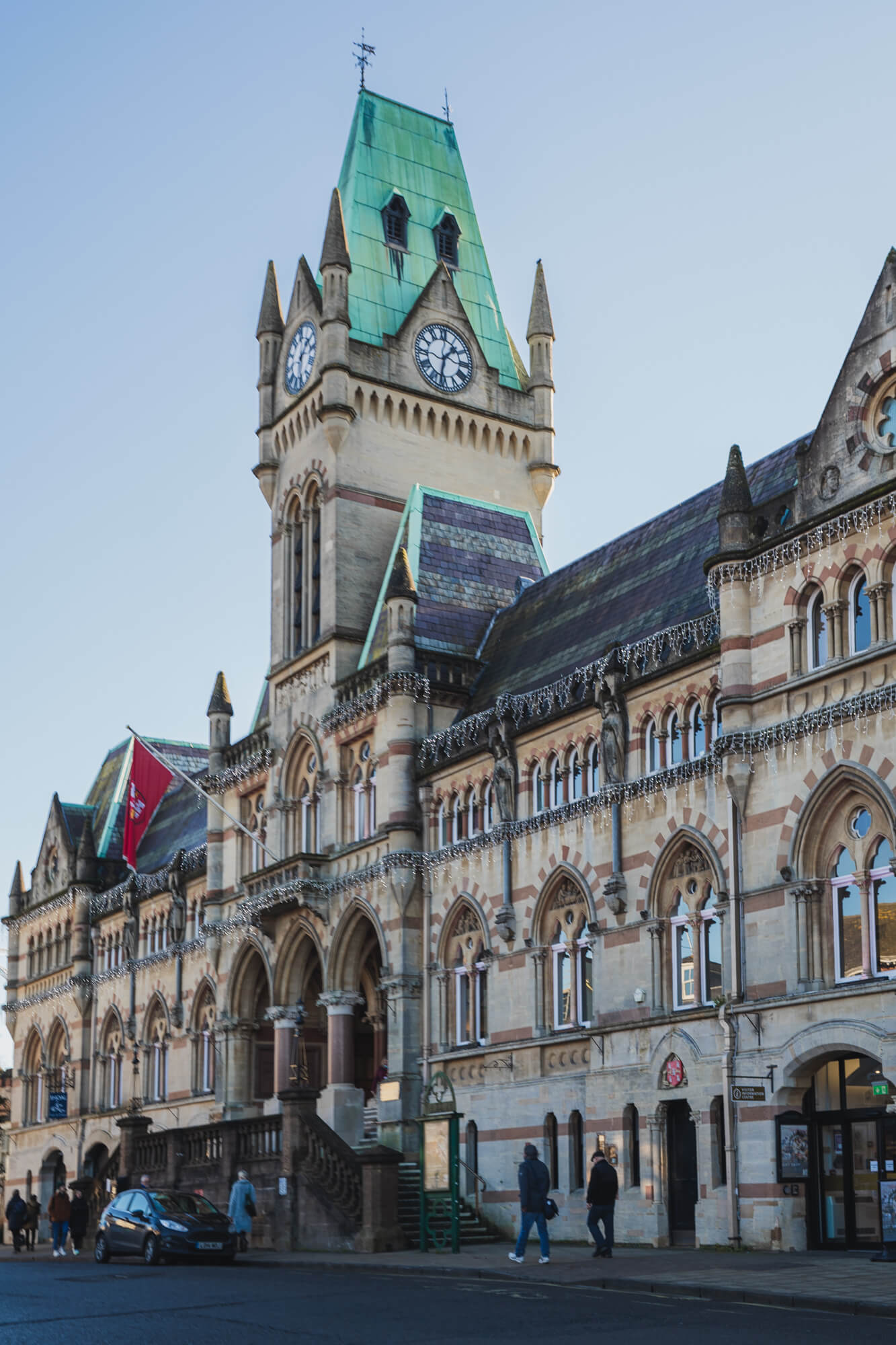
Wolvesey Castle
Back in the Middle Ages, this castle served as the main residence of the Bishops of Winchester and today the ruins are some of the most interesting things to see in Winchester.
Wolvesey Castle is sometimes called the Old Bishop’s Palace as it was constructed by the Bishop of Winchester (Æthelwold) as his personal palace between 963 and 984 AD. This palace was later famously the location for Queen Mary and Philip II of Spain’s wedding breakfast in 1554.
The castle was eventually destroyed during the English Civil War in 1646, but today the ruins are open for visitors to see the remains of the curtain walls and the outlines of the inner rooms.
PRACTICAL INFO FOR VISITING: Entry to Wolvesey Castle is free, but take note of opening times, as they are only open for weekends during the winter. You can see their operating hours here.

Winchester High Street
Winchester is a popular UK location for shopping, with the ideal mix of big-name stores, small independent boutiques and local markets.
The main shopping street is the picturesque High Street, with most of the shops located inside lovely old half-timbered buildings that make you feel like you could almost be walking down a street in Elizabethan England. Of course, the crowds at busy times (particularly Christmas) say otherwise!
Winchester’s High Street stretches from the Guildhall to the West Gate Museum, with almost a mile of shops, cafés and restaurants. Roughly in the middle is the Buttercross Monument (pictured below, on the left), a 15th-century monument showing carved figures of the Virgin Mary as well as the Saints Bartholomew, John, Lawrence, Maurice, Peter, Swithun, and Thomas.
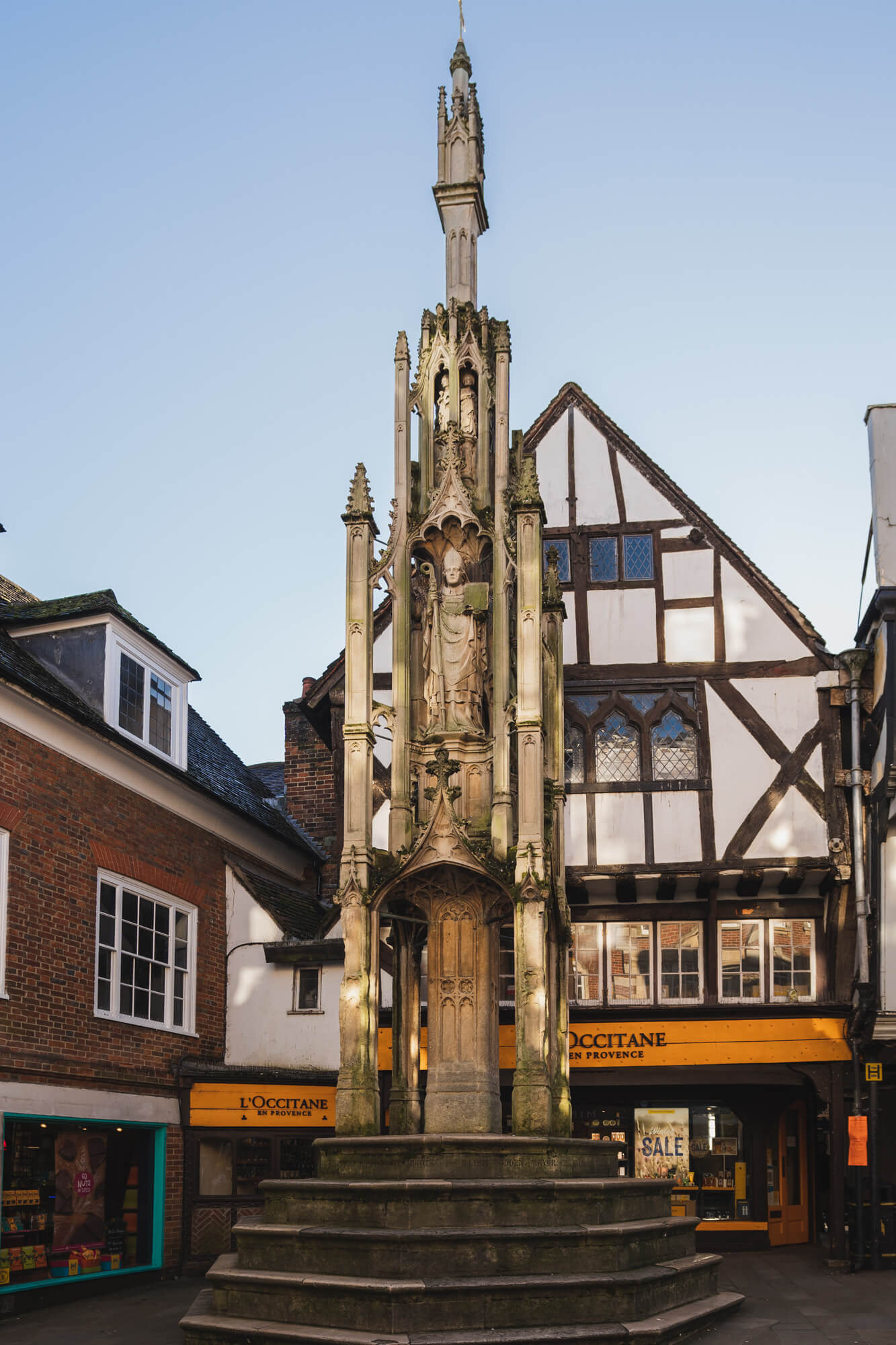
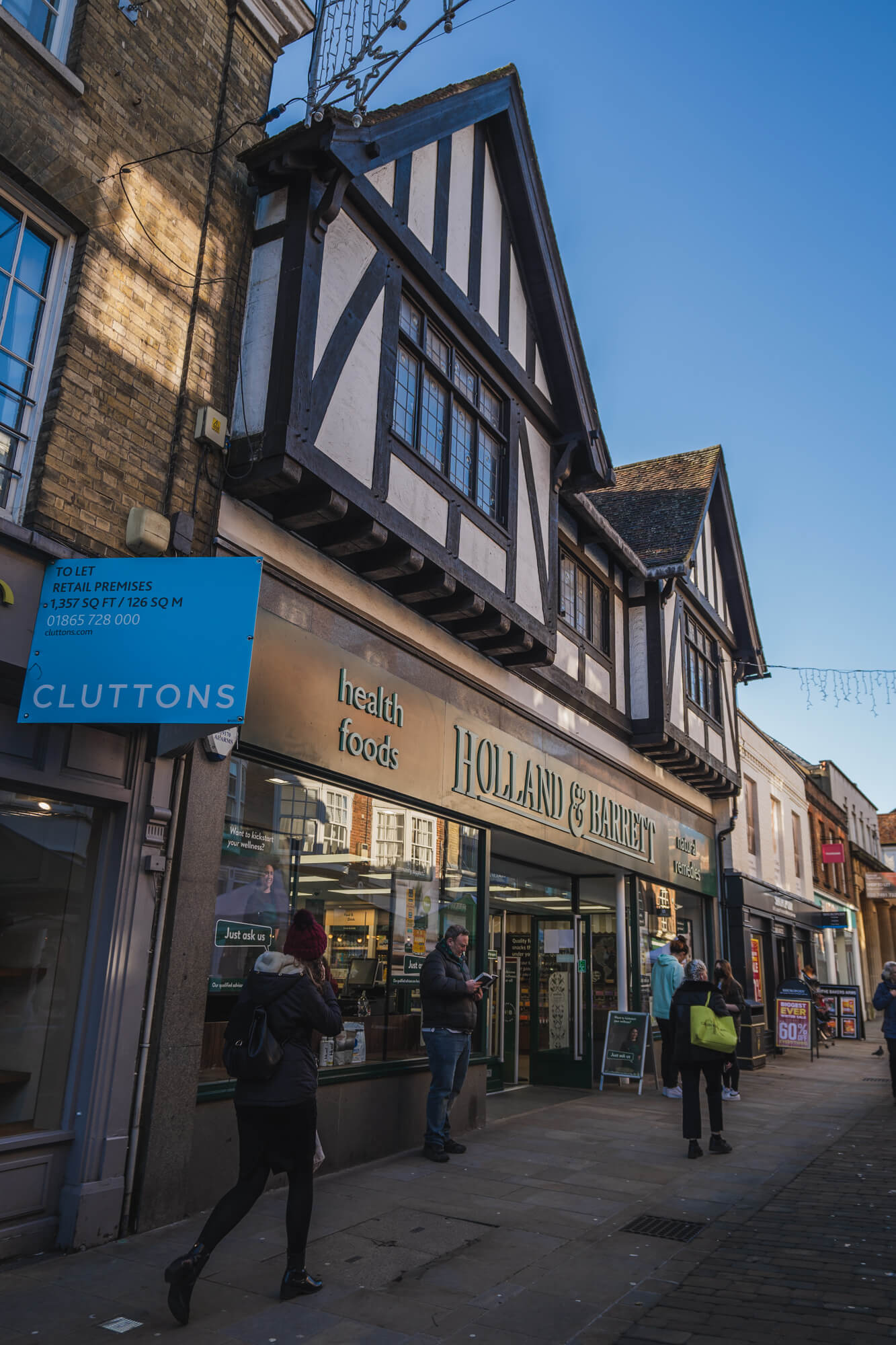
Winchester City Mill
Winchester once had many water mills on the banks of the River Itchen, and the still-standing Winchester City Mill is perhaps one of the oldest mills in the whole country.
Records show a mill standing on the spot since at least Saxon times, although the mill as it looks today was mostly reconstructed by James Cooke in the 1740s. He invested considerable money to make the mill look aesthetically pleasing, but still incorporated much of the original structure.
Today the Winchester City Mill is a Grade II listed building and managed by the National Trust, attracting more than 50,000 visitors per year! The mill is still used as a working flour mill, with regular events such as baking, making ceramics and weaving.
PRACTICAL INFO FOR VISITING: The Winchester City Mill is open Wednesday to Sunday although occasional events are held on Mondays and Tuesdays when it’s not open to the public. Entry is free unless you are booking a special workshop. There’s also a café and gift shop on the premises.
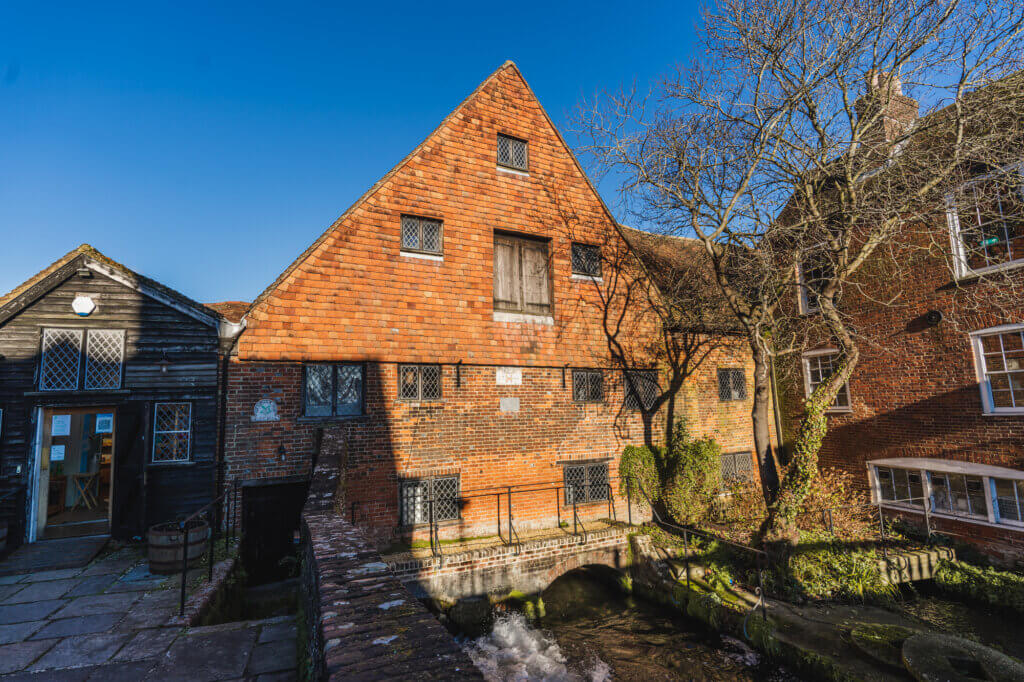
Winchester Military Quarter
Directly next to the Great Hall of Winchester Castle is a site that houses no fewer than six different military museums, together known as the Winchester Military Quarter.
Each of the museums is different and fascinating, telling the stories of a variety of aspects of English military history. Three of the museums are free to enter, while the other three have a small entrance fee.
The Winchester Military Quarter is home to the following museums:
- HorsePower: The Museum of The King’s Royal Hussars (£3) – about the cavalry regiment of the British Royal Army
- The Royal Hampshire Regiment Museum (free) – tells the story of the county infantry regiment for Hampshire and the Isle of Wight
- The Royal Green Jackets (Rifles) Museum (£5) – the history of The Royal Green Jackets regiments in the British Royal Army
- The Rifles Regimental Museum (free) – in the same building as the Royal Green Jackets Museum, find out what it is like to be a Rifleman
- The Gurkha Museum (£5) – the story of Gurkha service to the British Crown including information about Nepal, the land of the Gurkhas
- The Adjutant General’s Corps Museum (free) – information about the history of women in the British Army, along with how Britain’s soldiers were paid, educated, and disciplined
PRACTICAL INFO FOR VISITING: You can get a combined pass for the three museums that aren’t free to save a little money if you want to see them all, the pass costs £11. Check this page for the opening times of all six museums.
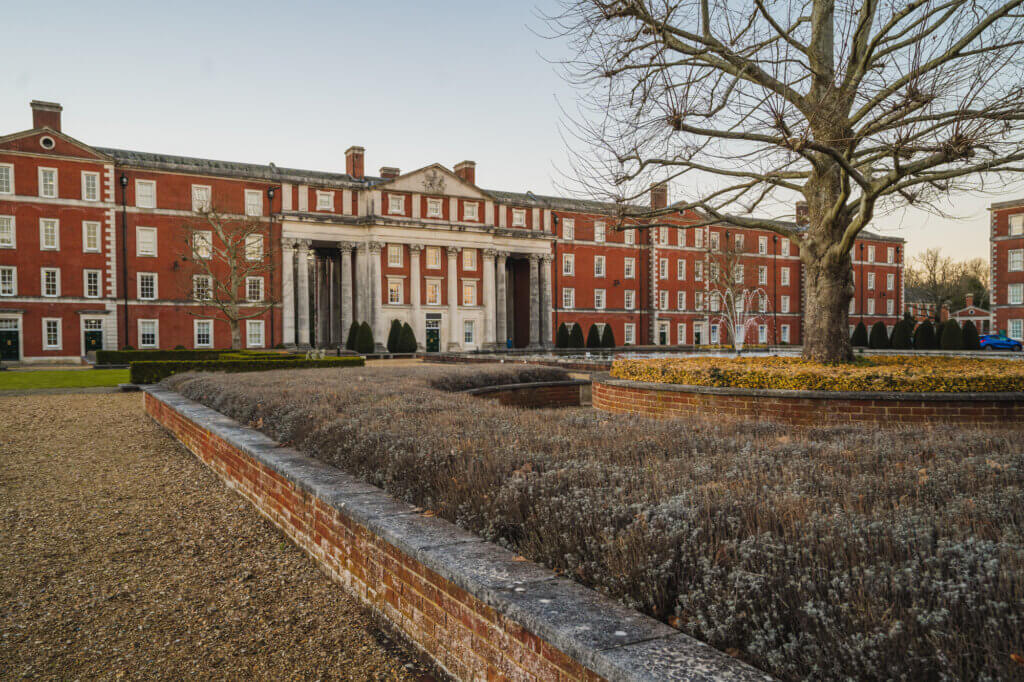
Wykeham Arms
Looking for a place to sit down for a drink or bite?
Be sure to spend some time at the Winchester pub called the Wykeham Arms, as it’s one of the most unusual places to visit in Winchester!
Since at least 1775, the Wykeham Arms has been a pub or a coaching inn as it was originally. Apparently, even Lord Nelson has stayed over on his way to Portsmouth.
Nowadays historic pieces decorate the walls – including old photos, a framed programme from Winston Churchill’s funeral and tons of Steins hanging from hooks all around. There are even coin slots for cathedral donations, along with gold plaques showing the names of regulars and when they sat there.
The Wykeham Arms is not just a bit quirky, it’s also got a real cosy and local vibe with tons of regulars flooding in at midday to have a chat with the bartender or sit by the roaring fire in winter.
Along with drinks and yummy pub food, the Wykeham Arms still provides accommodation, with luxurious bedrooms – some featuring four-poster beds, chandeliers and huge bathtubs.
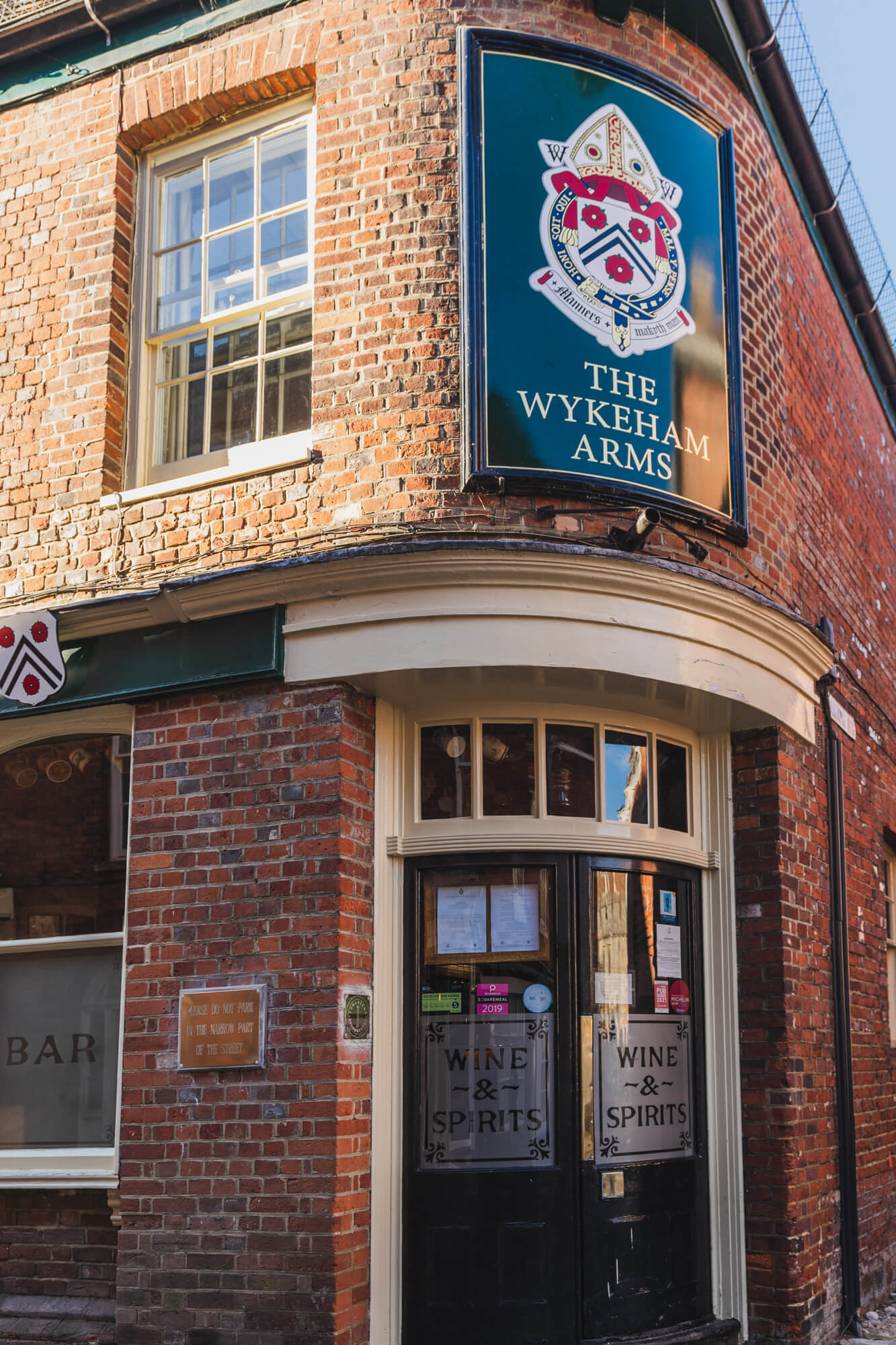
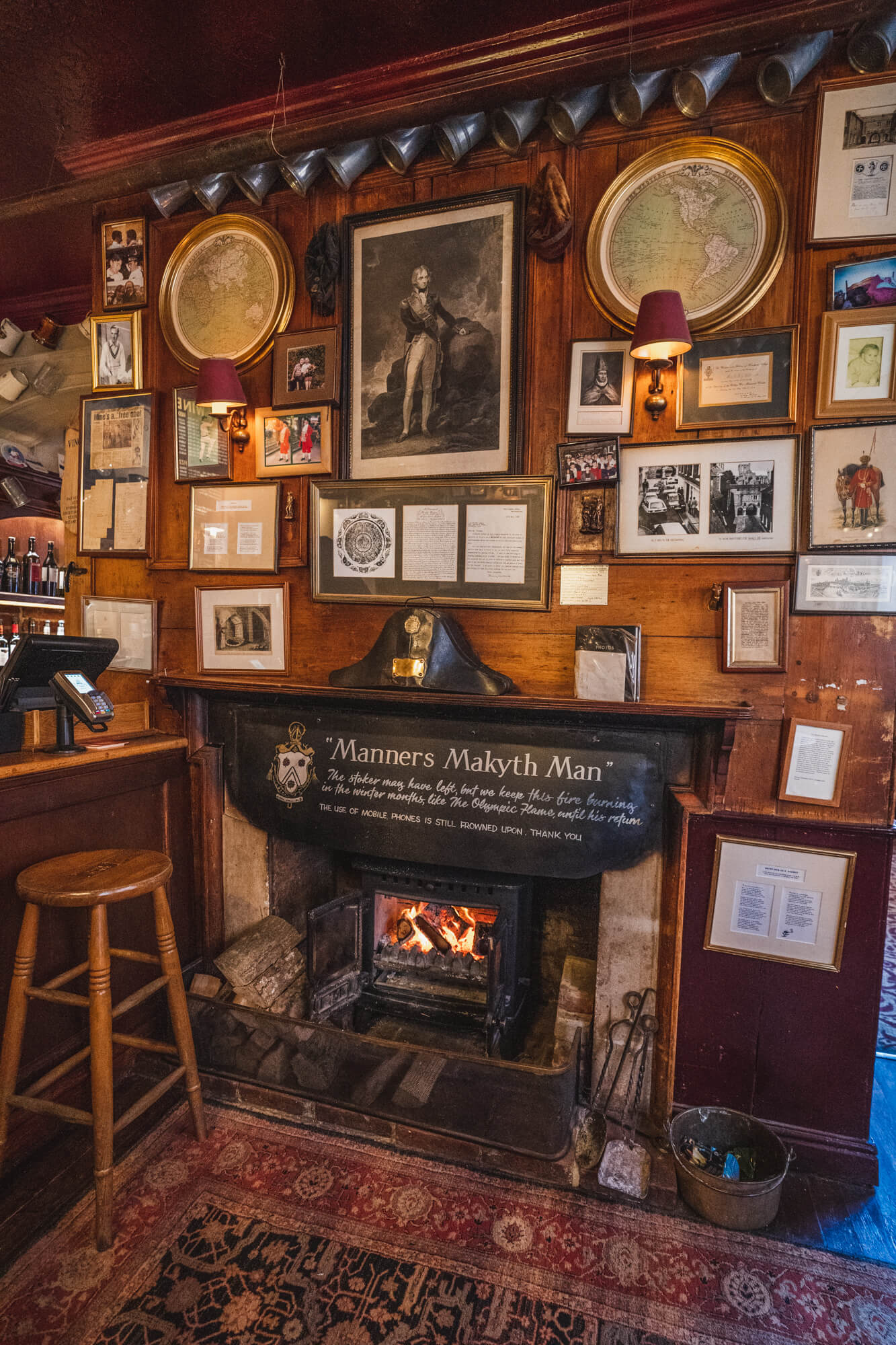
Be sure to also keep an eye out just across from this pub for a rare mounted Victorian postbox:
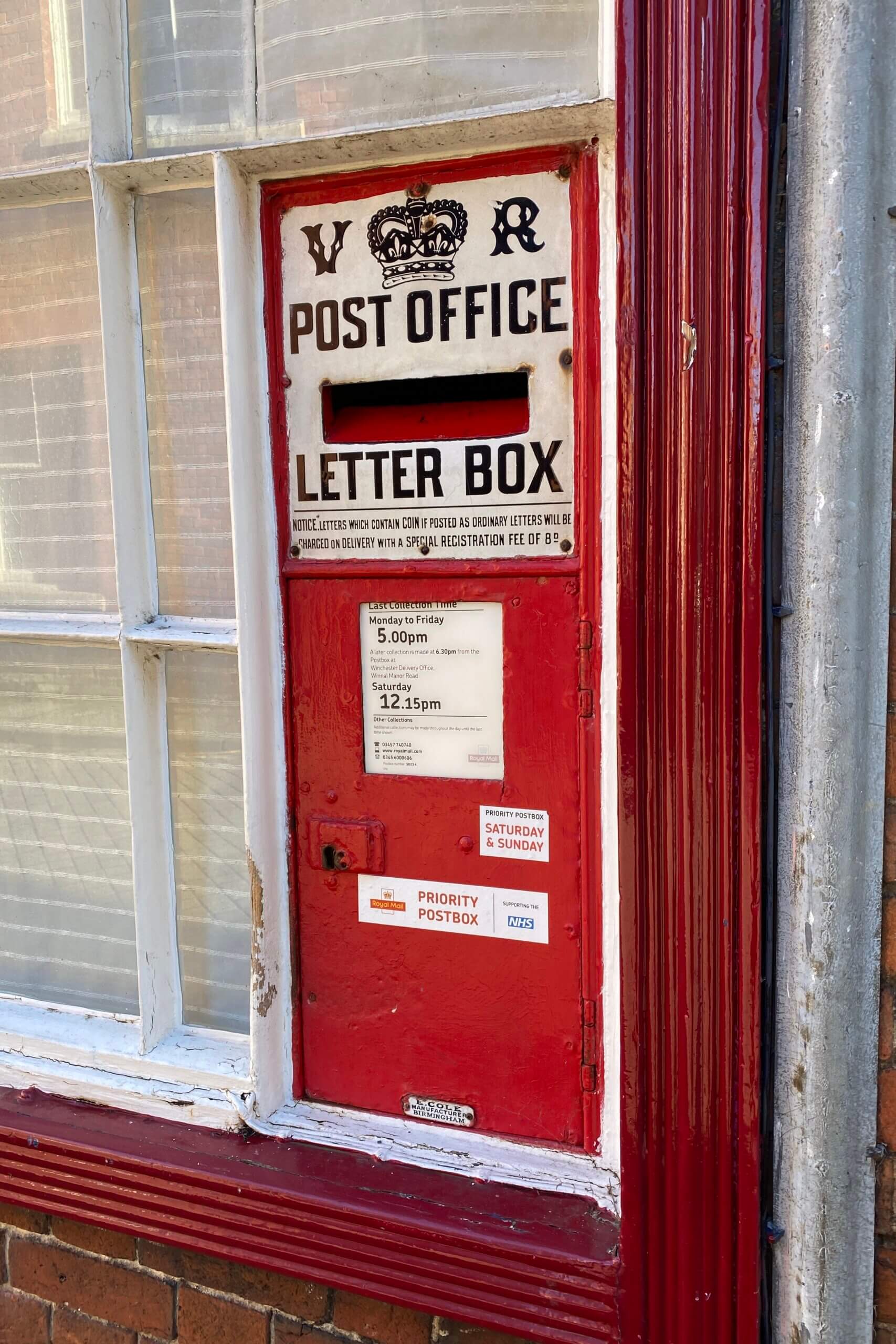
Kingsgate
There are two surviving medieval gates in Winchester; the Westgate on the High Street (which we mentioned earlier) and Kingsgate, which is right by Winchester Cathedral.
The name of Kingsgate was first recorded in 1148, although it’s believed to have been built either on or near one of the original Roman gates to the city. Directly above the gate is a tiny church that was built in the middle ages called St Swithun-upon-Kingsgate.
The church has been around since the 13th-century and was even mentioned in Anthony Trollope’s 1855 novel The Warden, although under the pseudonym of St Cuthbert’s.
These days, a visit to Kingsgate is mainly a scenic photo opp, but what a pretty one it is.
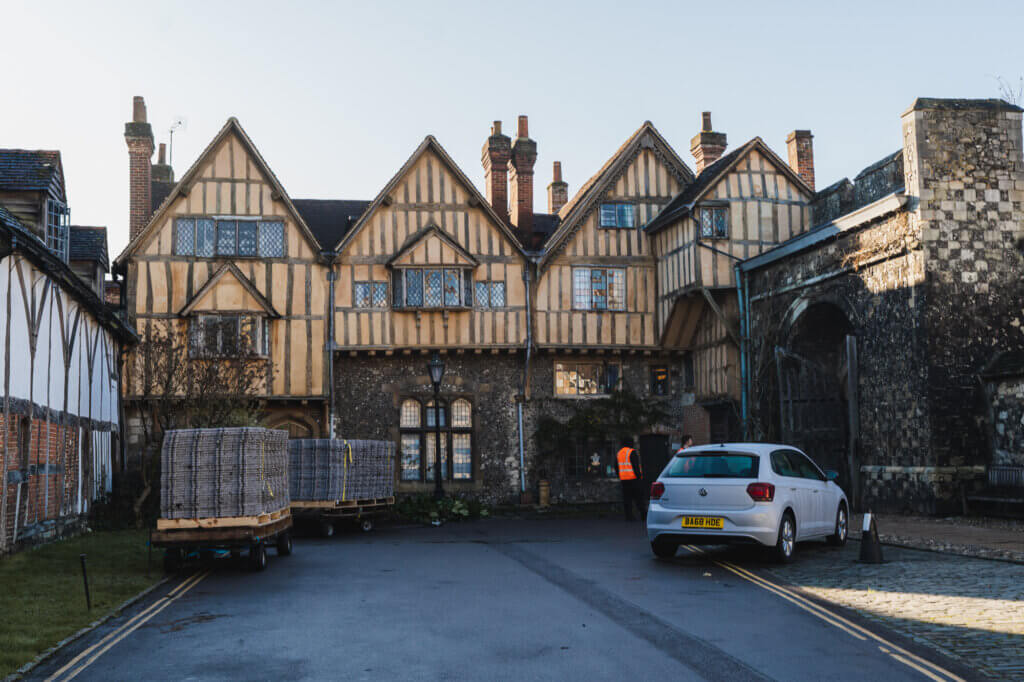
PS: For those looking for photogenic places to visit in Winchester, we’re especially fond of the Kingsgate Books & Prints (located right at Kingsgate). It may well be one of the most charming hidden corners of the city:
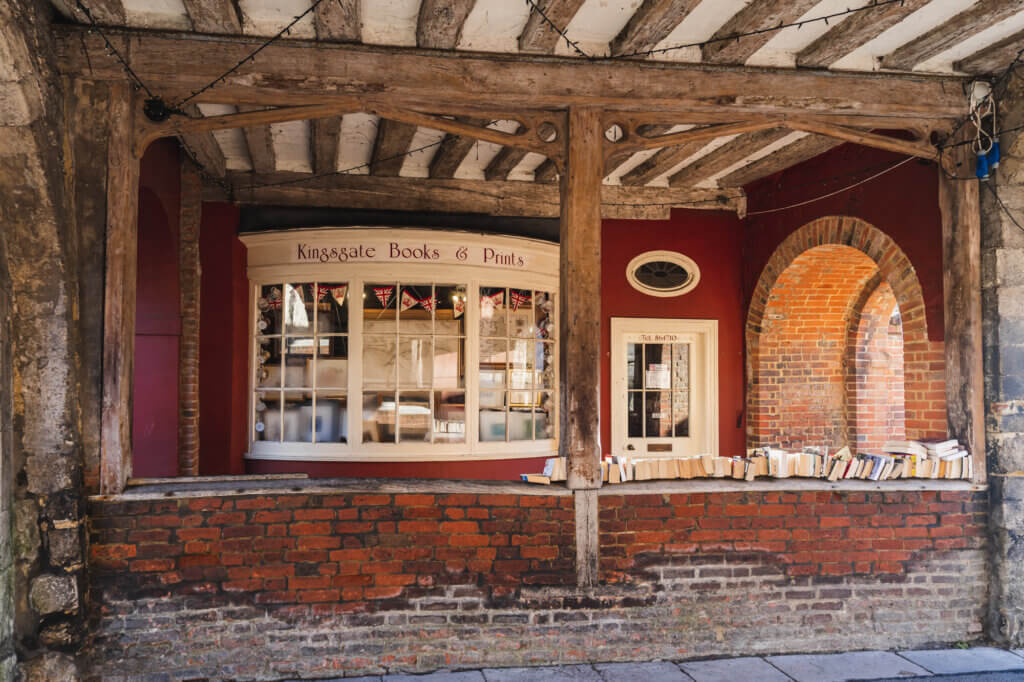
Jane Austen’s Last Home
This might be a morbid Winchester attraction to mention, but a worthwhile one nonetheless, particularly for fans of Jane Austen, the British novelist who penned famous favourites Pride & Prejudice, Sense & Sensibility, Emma and Persuasion (among others).
While Austen’s name is most commonly linked to places where she lived in her younger years, like Bath (and even Southampton), she actually spent the last months of her life in Winchester at 8 College Street.
Austen began feeling unwell in 1816 and her health continued to slowly decline until she stopped writing in March 1817. She and her sister Cassandra moved to Winchester so that the doctor who had previously treated her (who worked in Winchester) could continue to do so, but she died on the 18th of July 1817 at the age of 41.
The house where she died is not open to the public, but there is a plaque marking it out, so it’s a popular spot for Austen fans to come and see, before or after heading to her burial place in Winchester Cathedral.
NOTE: For especially keen Austen fans, in the north aisle of the nave of Winchester Cathedral, there’s a memorial gravestone with an epitaph for Austen written by her brother.
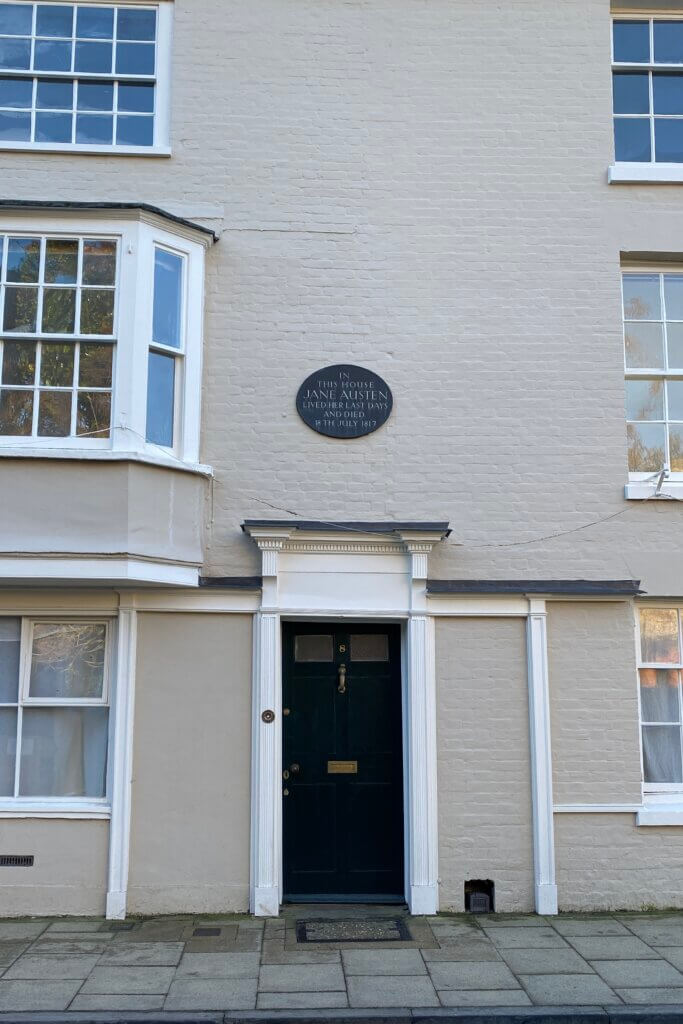
Winchester College
Directly next door to the house where Jane Austen lived for a time is the Headmaster’s House of Winchester College; one of the oldest and most prestigious secondary schools in the world.
Winchester College was founded in 1382 by William of Wykeham, who was Bishop of Winchester and Chancellor of England. He also founded New College in Oxford in 1379, with Winchester College intended as a ‘feeder school’ for Oxford.
For hundreds of years, Winchester College was a boarding school for boys, although there are plans currently underway to admit both day pupils and girls into the school from 2022 onwards.
The school features 11 acres of beautiful formal gardens, as well as more than 80 listed buildings, and a Treasury Museum which houses the school’s collections of art and archaeology. It has also been featured in numerous films and TV shows, including The Crown and Les Misérables (2012).
PRACTICAL TIPS FOR VISITING: Winchester College is a working school, and so access is only possible through one of their paid guided tours. Learn more about their tours here. Alternatively, you can visit the school for free during the Winchester Heritage Open Days, which run for ten days in September.
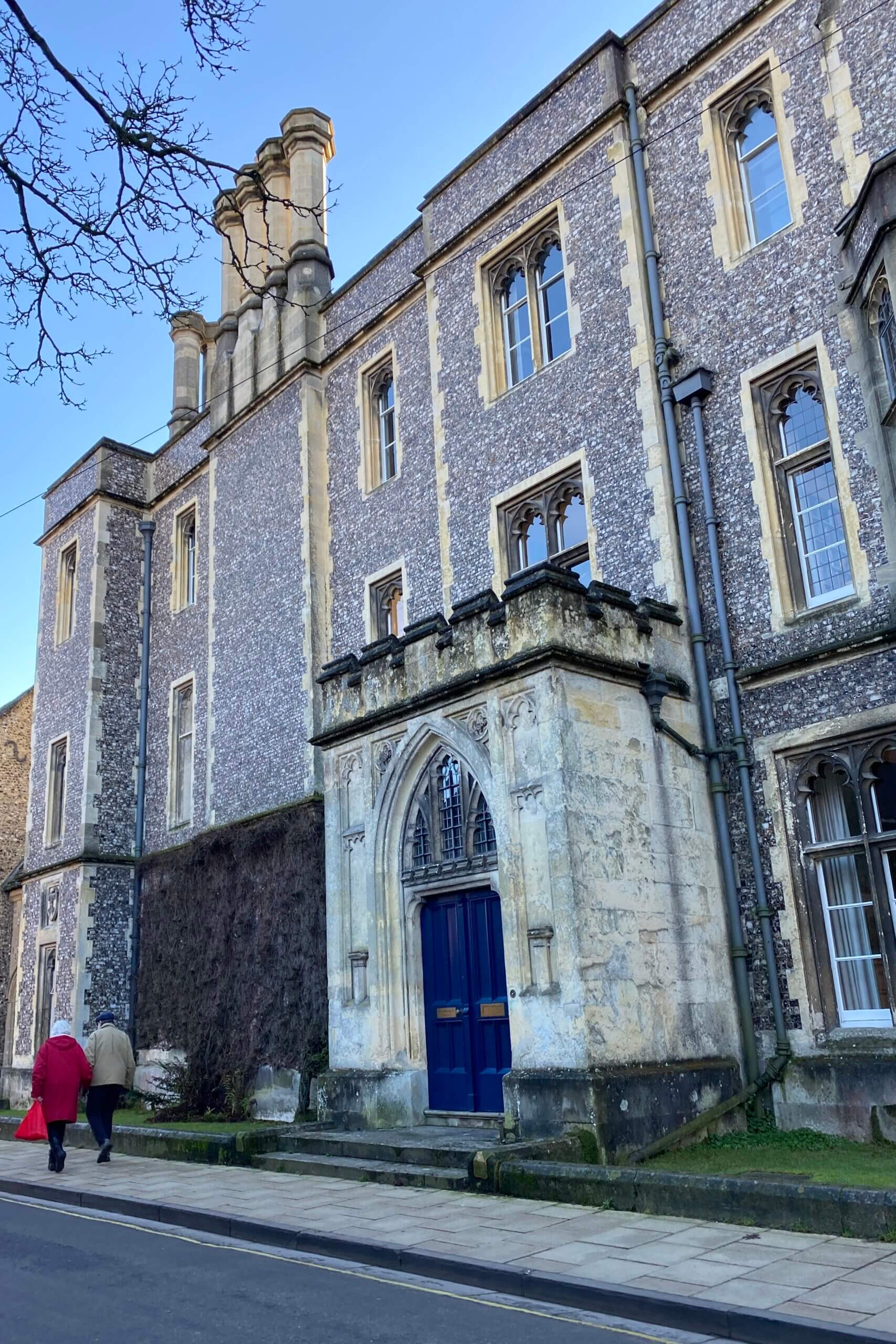
The Weirs
One of the best places to visit in Winchester for a relaxing stroll in nature is a walking path along the banks of the River Itchen known as The Weirs.
The River Itchen is a chalk stream, which means the water is very clear, without much sediment. In some sections, particularly near the Winchester City Mill, the water runs very fast, up to 25mph, because the river runs down into a valley from its source.
The stretch of water which runs between the City Mill and the Wharf Mill is known as The Weirs. Here the flow is slightly slower and there’s a walking path along the river banks with many benches to sit and enjoy the peaceful surroundings. There are some small dams (called weirs, which is how the area got its name) in the river here, to control the level and flow of the water.
On a warm sunny day, this leisurely walk is a delight. It’s also the prettiest way to head to Wolvesey Castle after visiting the City Mill, or vice versa.
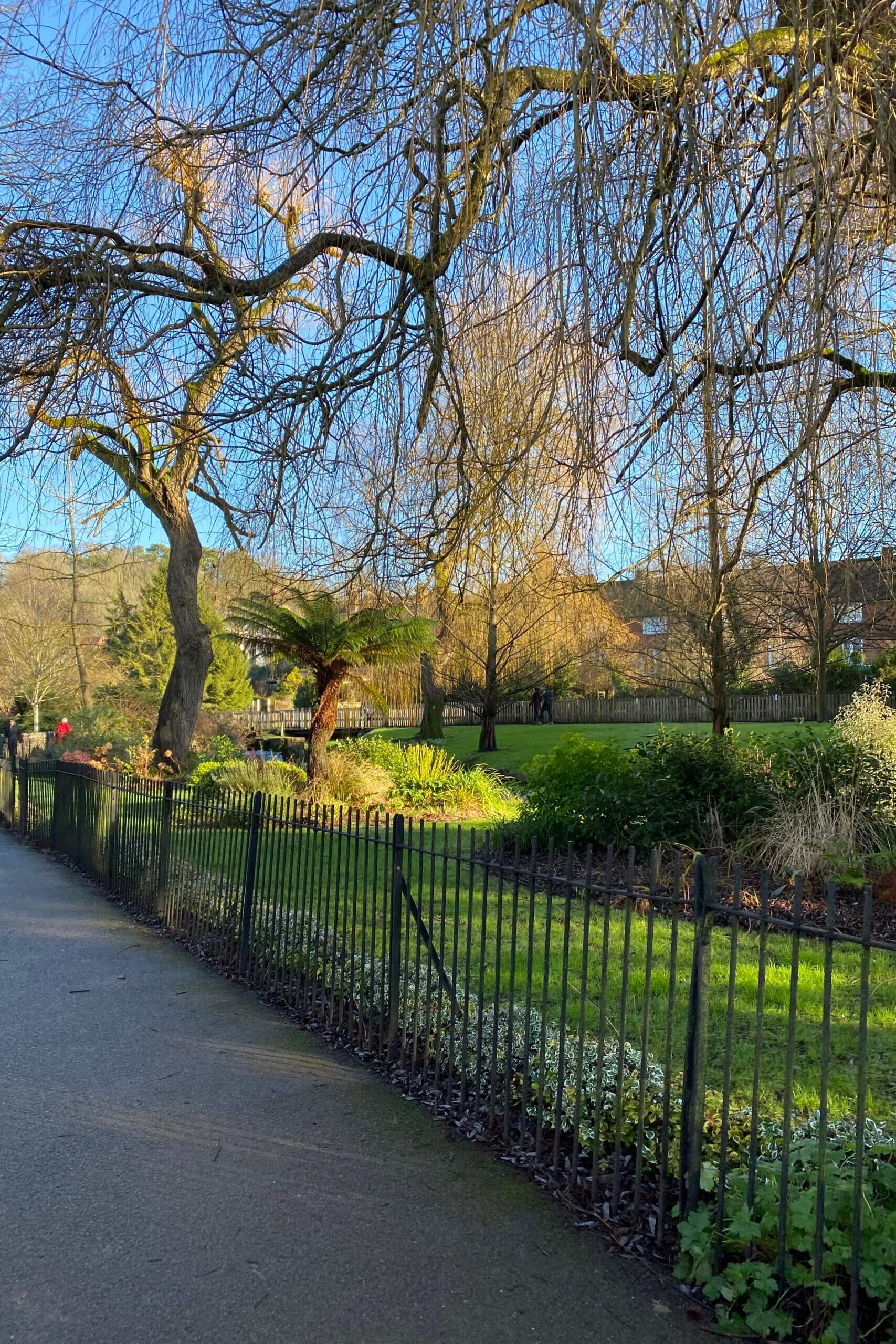
The Royal Oak
Though a hotly contested claim, the Royal Oak is a historic pub in Winchester that beckons you with a sign declaring its status as “the oldest bar in England”.
These days, the Royal Oak is part of the Greene King chain of pubs, with a relatively modern menu and experience; you can even order through an app! There’s also a completely gluten-free menu and some vegan or vegetarian options.
As such, it’s not exactly the cosy historic pub feel you might be looking for, but if you are (like us) a sucker for a good story, and want to enjoy a pint in at least one of the oldest bars in the country, then The Royal Oak is no doubt a place you must visit in Winchester.
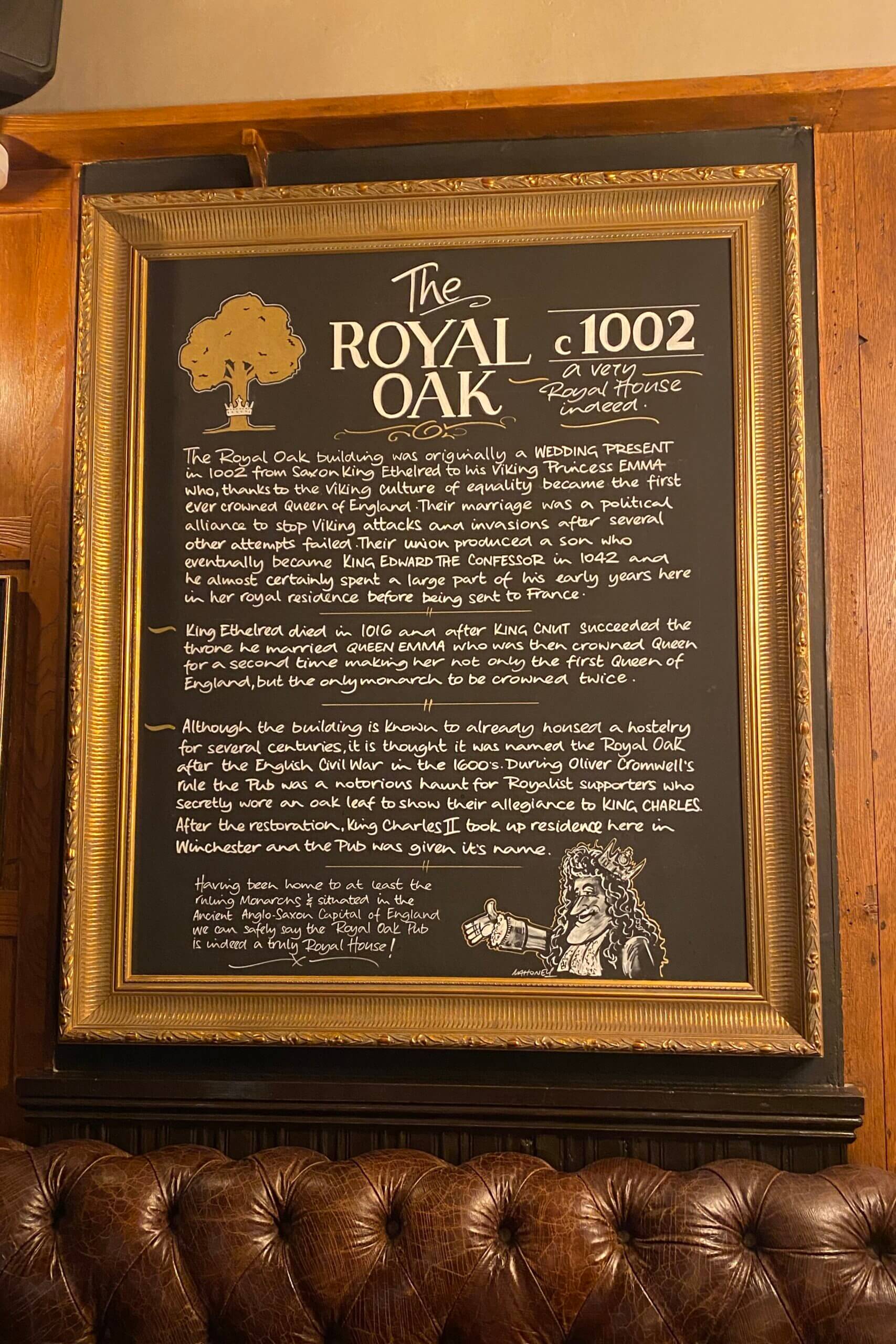
Winchester City Museum
If you’re looking for places to go in Winchester to learn about its history then you cannot miss the Winchester City Museum.
The city of Winchester was once the capital city of England, under the reign of King Alfred the Great and there are some fascinating exhibits at the City Museum about this time period.
Of course, other historic times are also included, with a scale model of the city as it looked in the Victorian era along with a section on Venta Belgarum, as Winchester was known during the Roman period.
The Winchester City Museum is particularly fun for children (or the young at heart) as it has costumes to try on and interactive activities. Visitors can also buy a combined ticket to see both the City Museum and the Westgate Museum for a small discount.
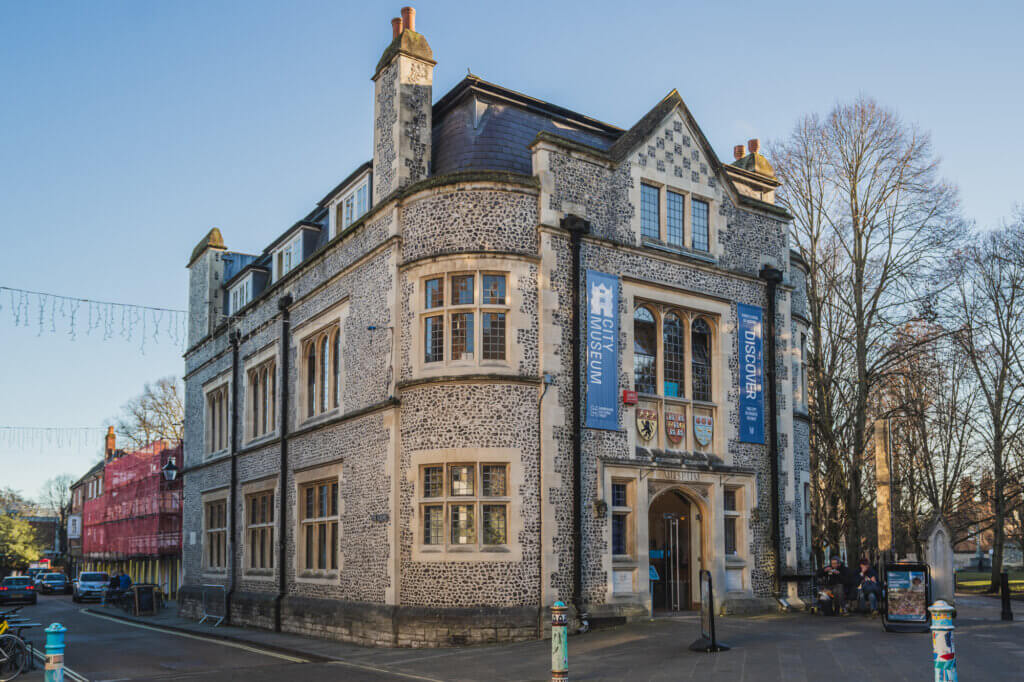
Black Boy Pub
Another unusual spot in Winchester is the Black Boy Pub, which features some very eclectic decor with taxidermy, large movie posters and assorted knick-knacks adorning the exposed wood beam throughout the pub.
The Black Boy prides itself on being a proper ‘back street boozer’, with a focus on serving local ales along with a small wine list. Patrons can sit inside (with a roaring fire in winter) and enjoy the ‘antique emporium’ feel or outside in the sheltered garden, which has heaters in colder weather.
The pub is located in a more residential neighbourhood of Winchester, across the River Itchen from Wolvesey Palace. It makes for another excellent location to walk along The Weirs and visit for a break from exploring with a nice drink!

St Giles Hill
One of the best Winchester destinations for stunning views is the top of St Giles Hill. Here you can enjoy a panoramic view of all the main sights as well as a picture showing how the city looked during medieval times.
St Giles Hill is located on the eastern side of Winchester and is named for a medieval chapel which once stood there but was later demolished. The hill was also the location of the St Giles Fair, the largest and most profitable medieval fair in the whole of Europe. The fair was held every year from 1096 until the 13th-century and took place for sixteen days around the feast of St Giles, which takes place on the 1st of September.
The viewing point at the top of the hill can be reached either by walking up a fairly steep slope, or 150 stairs. Luckily there are plenty of benches if you need a rest after the walk!
If you’re looking to make a longer outing of it, there’s also a lovely big open green on top of the hill for picnics or kids to run around.
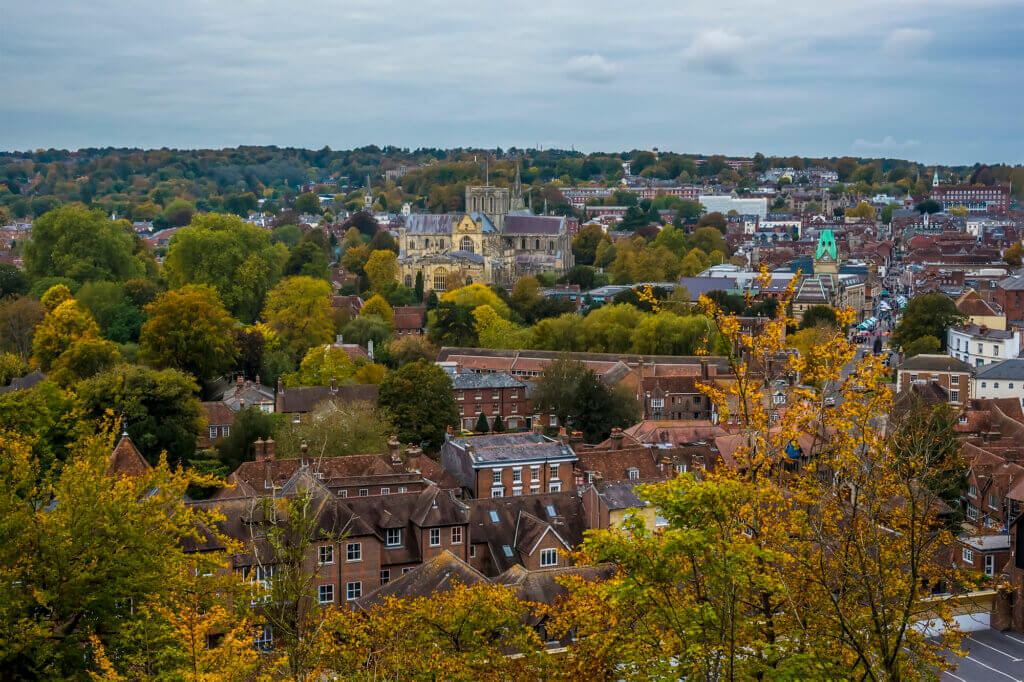
BONUS: Josie’s
While it may not show up on your typical list of Winchester tourist attractions, a meal at Josie’s was one of the best things we stumbled upon while exploring the city.
There are four Josie’s Cafés in Hampshire, which all serve delicious food and coffee, as well as some of the biggest pancake stacks we’ve ever seen! Along with mouth-watering varieties such as banoffee pancakes, Biscoff pancakes or Oreo pancakes, you can also get a pancake stack like the one below which includes fried chicken, a fried egg and maple syrup on top.
If you don’t think you can manage that much food there are other yummy options, along with some amazing smoothies and milkshakes. Honestly, we’d go back to Winchester purely for another meal at Josie’s!
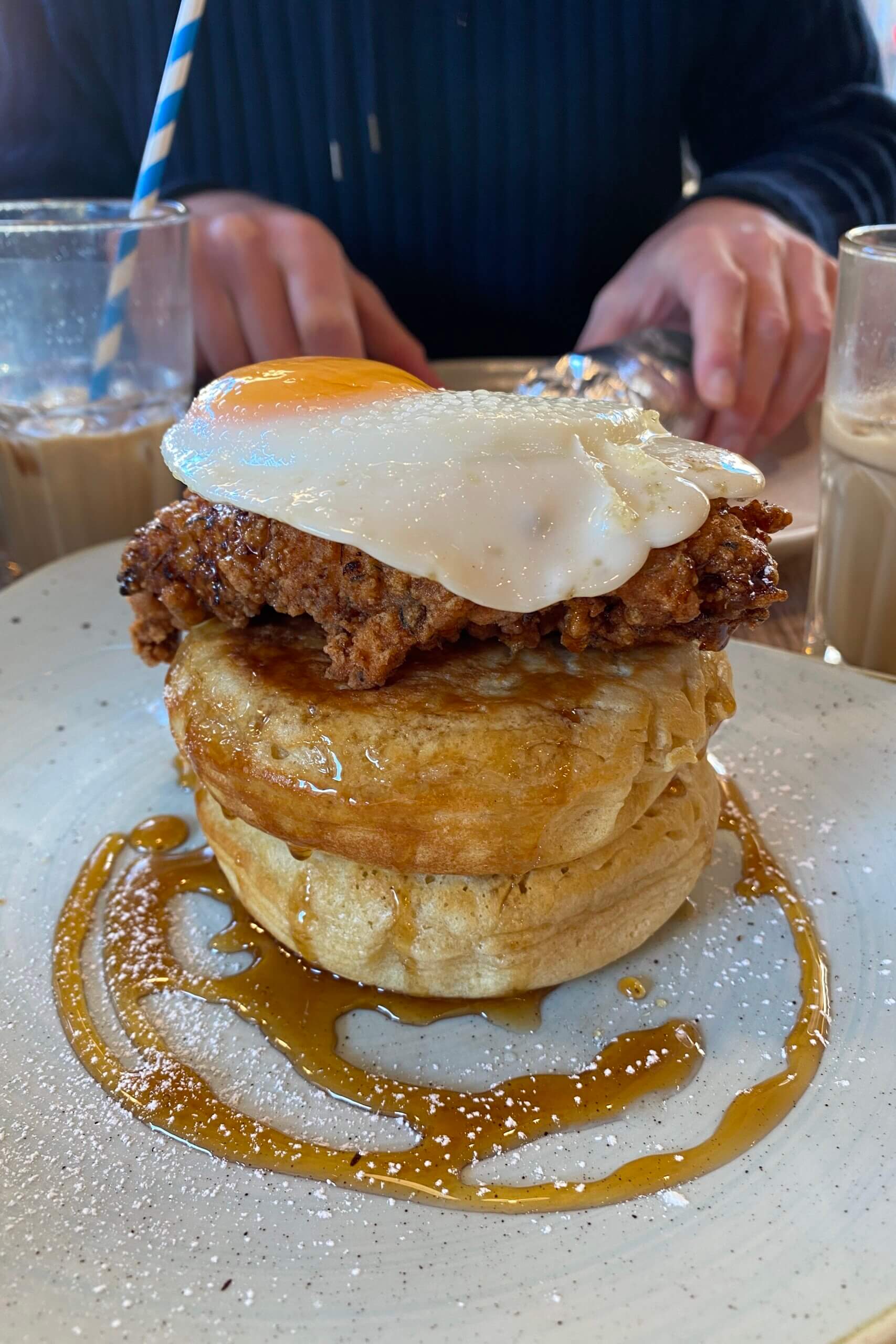
Did we miss any of your favourite places to visit in Winchester?
Let us know in the comments so we can add more Winchester must-sees to our list!
